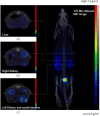Synthesis and characterisation of DOTA-kisspeptin-10 as a potential gallium-68/lutetium-177 pan-tumour radiopharmaceutical
- PMID: 39775975
- PMCID: PMC11919473
- DOI: 10.1111/jne.13487
Synthesis and characterisation of DOTA-kisspeptin-10 as a potential gallium-68/lutetium-177 pan-tumour radiopharmaceutical
Abstract
Kisspeptin (KISS1) and its cognate receptor (KISS1R) are implicated in the progression of various cancers. A gallium-68 labelled kisspeptin-10 (KP10), the minimal biologically active structure, has potential as a pan-tumour radiopharmaceutical for the detection of cancers. Furthermore, a lutetium-177 labelled KP10 could find therapeutic application in treating oncological diseases. DOTA (1,4,7,10-tetraazacyclododecane-1,4,7,10-tetraacetic acid) was attached to the NH2-terminus of KP10 as we posited from our previous publications that this modification would not impair biological activity. Here, we showed that the biological activity, as monitored by stimulation of inositol phosphate accumulation in HEK293 transfected with the KISS1R gene, was indeed similar for KP10 and DOTA-KP10. The optimisation of radiolabelling with gallium-68 and lutetium-177 is described. Stability in serum, plasma and whole blood was also investigated. Pharmacokinetics and biodistribution were established with micro-PET/CT (positron emission tomography/computerised tomography) and ex vivo measurements. Dynamic studies with micro-PET/CT demonstrated that background clearance for the radiopharmaceutical was rapid with a blood half-life of 18 ± 3 min. DOTA-KP10 demonstrated preserved functionality at KISS1R and good blood clearance. These results lay the foundation for the further development of DOTA-KP10 analogues that have high binding affinity along with proteolytic resistance.
Keywords: antimetastatic; peptide receptor radionuclide therapy (PRRT); pharmacokinetics; positron emission tomography (PET); tumorigenesis.
© 2025 The Author(s). Journal of Neuroendocrinology published by John Wiley & Sons Ltd on behalf of British Society for Neuroendocrinology.
Figures









Similar articles
-
In vivo and in vitro evaluation of 177Lu-labeled DOTA-2-deoxy-D-glucose in mice. A novel radiopharmaceutical agent for cells imaging and therapy.Hell J Nucl Med. 2019 May-Aug;22(2):103-110. doi: 10.1967/s002449911002. Epub 2019 Jul 7. Hell J Nucl Med. 2019. PMID: 31273351
-
Tailoring Fibroblast-Activation Protein Targeting for Theranostics: A Comparative Preclinical Evaluation of the 68Ga- and 177Lu-Labeled Monomeric and Dimeric Fibroblast-Activation Protein Inhibitors DOTA.SA.FAPi and DOTAGA.(SA.FAPi)2.Molecules. 2024 Jun 28;29(13):3093. doi: 10.3390/molecules29133093. Molecules. 2024. PMID: 38999044 Free PMC article.
-
In Vivo Labeling of Plasma Proteins for Imaging of Enhanced Vascular Permeability in the Lungs.Mol Pharm. 2018 Nov 5;15(11):4995-5004. doi: 10.1021/acs.molpharmaceut.8b00606. Epub 2018 Sep 28. Mol Pharm. 2018. PMID: 30265552
-
A Review of Accelerator-Produced Ga-68 with Solid Targets.Curr Radiopharm. 2021;14(4):315-324. doi: 10.2174/1874471013666201224113651. Curr Radiopharm. 2021. PMID: 33357189 Review.
-
Gallium-68 PET: a new frontier in receptor cancer imaging.Anticancer Res. 2007 Nov-Dec;27(6B):4087-94. Anticancer Res. 2007. PMID: 18225576 Review.
References
MeSH terms
Substances
LinkOut - more resources
Full Text Sources
Medical

